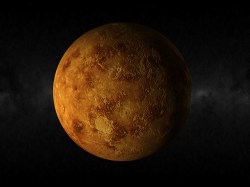Imagine Earth with toxic air, stifling heat, no water, and no signs of life — sort of like Los Angeles. This is a world laid bare by massive and catastrophic climate change, and believe it or not, it isn’t science fiction. It’s our neighbor, Venus, and it’s more similar to Earth than you might want to believe.
Venus and Earth have a lot in common: They’re practically the same size, they’re made up of basically the same stuff, and early in the life of our solar system they were nearly identical, right down to oceans and moderate atmospheres. But then climate change arrived on Venus — the same processes that are playing out on our planet today with rising carbon dioxide and an increasing greenhouse effect — and transformed the planet into an uninhabitable, 900-degree-F wasteland swathed in clouds of sulfuric acid.
“It’s almost as if you had a twin study — you take these identical twins and give them different experiences in life and see how they grow up,” says David Grinspoon, an astrobiologist with the Denver Museum of Nature & Science and the NASA-sponsored astrobiology chair at the Library of Congress’s John W. Kluge Center.
Comparing planets and their evolutions is Grinspoon’s bread and butter, and Venus is one of his favorite subjects. “It gives us a laboratory to see if we really understand atmosphere and climate as well as we think we do,” he says. After all, physics is physics everywhere and chemistry is chemistry everywhere. So if our climate models on Earth are any good, we should be able to tweak the inputs and run them on Venus too.
Clearly we’re in no real danger of turning Earth into Venus anytime soon. But Grinspoon says that Venus is a sort of parable for what might happen if we keep pushing our climate system farther and farther out of balance.
Listen to my interview with Grinspoon below — and lest you think it’s all about climate apocalypse, we also took some time to discuss George Carlin’s philosophy of environmentalism, the “canals” on Mars, and Grinspoon’s old friend Carl Sagan.
This interview is part of the Generation Anthropocene project, in which Stanford students partake in an inter-generational dialogue with scholars about living in an age when humans have become a major force shaping our world.




